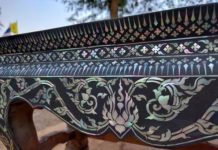
Damascus mother of pearl inlay is a style of craft that can be applied to any form of furniture, wall and ceiling panel or household object. Dating back several hundred years, the style is exclusive to the Damascus Governorate of Syria.
The materials employed include, but are not limited to, local walnut wood, silver thread, mother of pearl, camel bone and finer decorative woods such as lemon, olive and Brazilian rosewood.

A pre-drawn pattern, consisting of either an organic plant or geometric theme, is glued onto a walnut wood base. Channels are carved out for silver thread to be hammered and glued into place. Segments of the pattern are individually chiselled and inlaid with mother of pearl. Further embellishment may be added in the form of chemically treated camel bone and softer decorative woods. The piece is then polished and coated with lacquer. The techniques employed vary in complexity depending on the object. A chair being crafted in this style would traditionally be upholstered with local silk brocade.
The mother of pearl (also known as nacre) used in the early days of the craft was sourced locally from the Euphrates River in Deir ez-Zor Governorate. It has a dull white lustre. As international trade increased, craftsmen shifted to seawater nacre imported from the Philippines, China and New Zealand. Seawater nacre has a superior lustre and colour variation, including white, green and black.
The techniques have traditionally been passed down from generation to generation. Artisans interested in learning the craft can be expected to undertake apprenticeships of no less than five years and can remain under the mentorship of a master craftsmen for up to fifteen years before completing works independently.
The Syrian conflict has had a heavy toll on the craft. Local sources believe the current number of craftsmen and workshops in operation to be less than twenty percent of its previous state. Working conditions for the craftsmen that remain are rendered even more difficult by international sanctions. Despite the difficulties, local support and international demand remain strong. Pieces are often shipped to Gulf Arab nations and Europe.
Historically, this craft has been associated with the aristocracy and affluent tradesmen of Arab society. Damascus is host to a number of palaces, court yard homes and museums displaying countless antiques fashioned in this signature style. For more contemporary pieces, one can wander the streets of Old Damascus and visit one of the many furniture galleries exhibiting such items for sale.
During Ottoman rule, craftsmen were assigned surnames based on their speciality. For example, the Sanadiki family were famed for their skill in crafting boxes made in this style. Other surnames historically associated with the craft include Almaz, Sursor and Ozanian. Today the most prominent craftsmen associated with this style include Bashar Kazzaz, Imad Nakhle and Mohamad Kheir Hamcho.



